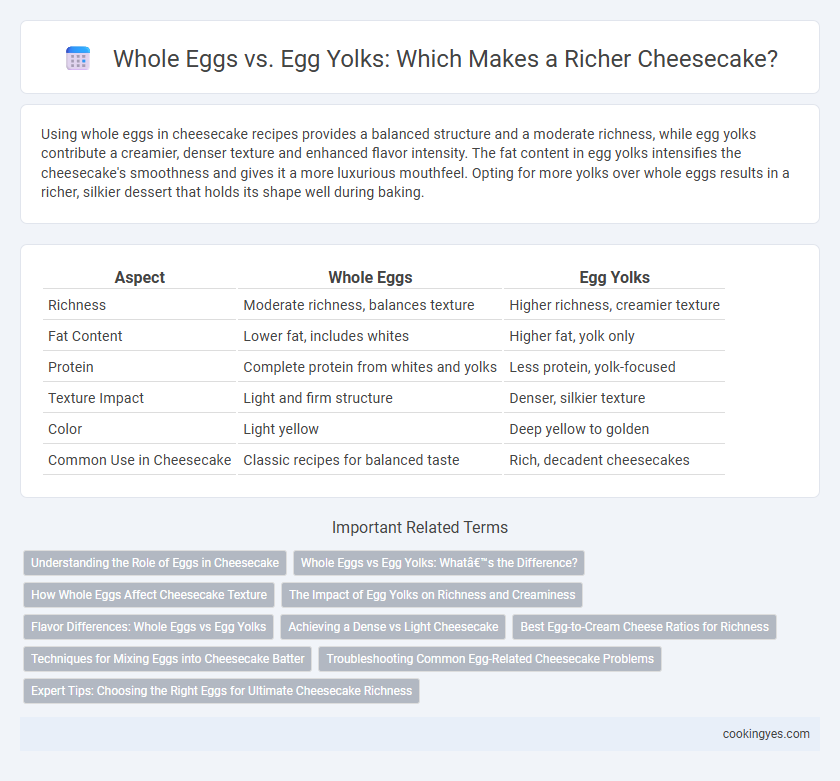Using whole eggs in cheesecake recipes provides a balanced structure and a moderate richness, while egg yolks contribute a creamier, denser texture and enhanced flavor intensity. The fat content in egg yolks intensifies the cheesecake's smoothness and gives it a more luxurious mouthfeel. Opting for more yolks over whole eggs results in a richer, silkier dessert that holds its shape well during baking.
Table of Comparison
| Aspect | Whole Eggs | Egg Yolks |
|---|---|---|
| Richness | Moderate richness, balances texture | Higher richness, creamier texture |
| Fat Content | Lower fat, includes whites | Higher fat, yolk only |
| Protein | Complete protein from whites and yolks | Less protein, yolk-focused |
| Texture Impact | Light and firm structure | Denser, silkier texture |
| Color | Light yellow | Deep yellow to golden |
| Common Use in Cheesecake | Classic recipes for balanced taste | Rich, decadent cheesecakes |
Understanding the Role of Eggs in Cheesecake
Whole eggs contribute structure and stability to cheesecake by coagulating during baking, while egg yolks enhance richness and creaminess due to their higher fat content. Egg yolks provide a smoother texture and a more custard-like consistency, making the cheesecake denser and silkier. Balancing whole eggs and egg yolks is crucial for achieving the ideal combination of firmness and lusciousness in the final dessert.
Whole Eggs vs Egg Yolks: What’s the Difference?
Whole eggs provide a balanced structure and moisture in cheesecake, contributing to a smooth and firm texture, while egg yolks add intense richness and creaminess due to their higher fat content. Using whole eggs results in a lighter, more set cheesecake, whereas relying on egg yolks yields a denser, silkier dessert with enhanced flavor depth. Adjusting the ratio of whole eggs to egg yolks allows bakers to control the cheesecake's texture and richness to achieve the desired mouthfeel.
How Whole Eggs Affect Cheesecake Texture
Whole eggs contribute to a denser, firmer cheesecake texture due to the protein structure formed during baking, which helps the cake set properly. The whites in whole eggs add stability and prevent cracking by coagulating and providing structure, while the yolks enrich the batter with fat, enhancing creaminess. Using whole eggs instead of just yolks results in a balanced texture that is smooth yet resilient, avoiding excessive richness or overly custardy softness.
The Impact of Egg Yolks on Richness and Creaminess
Egg yolks significantly enhance cheesecake richness and creaminess due to their higher fat content and emulsifying properties compared to whole eggs. The lipids in yolks contribute to a velvety texture, resulting in a denser and smoother consistency. Using primarily yolks allows for a more luxurious mouthfeel and deeper flavor profile in classic and New York-style cheesecakes.
Flavor Differences: Whole Eggs vs Egg Yolks
Whole eggs impart a balanced flavor and firmer texture to cheesecake, while egg yolks provide a richer, creamier taste with enhanced custard-like smoothness. The fat content in egg yolks intensifies the cheesecake's buttery notes, contributing to a more decadent mouthfeel. Using mostly egg yolks creates a silkier, denser dessert, whereas whole eggs maintain structure with a lighter richness.
Achieving a Dense vs Light Cheesecake
Whole eggs contribute to a denser cheesecake by providing structure and firmness due to the combined protein content of whites and yolks. Using only egg yolks enhances richness and creaminess while yielding a lighter, more delicate texture because yolks contain fats and emulsifiers without the firming effect of whites. Opting for whole eggs balances density and softness, whereas egg yolks alone create a smoother, less firm cheesecake with pronounced richness.
Best Egg-to-Cream Cheese Ratios for Richness
Using whole eggs in cheesecake provides a balanced texture, while egg yolks intensify richness by adding more fat. The ideal egg-to-cream cheese ratio for a creamy, dense cheesecake ranges from 1:3 to 1:4, meaning one egg (or yolk) per three to four parts cream cheese by weight. Adjusting this ratio with extra yolks enhances silkiness and depth without compromising structure, making it essential for achieving optimal cheesecake richness.
Techniques for Mixing Eggs into Cheesecake Batter
Incorporating whole eggs into cheesecake batter provides structure and a balanced richness, while egg yolks contribute a denser, creamier texture due to their higher fat content. Techniques such as gently folding beaten egg yolks or whole eggs into the cream cheese mixture prevent overmixing, which can cause cracking during baking. Gradually integrating eggs at room temperature ensures a smooth, homogenous batter, crucial for achieving a silky, luscious cheesecake consistency.
Troubleshooting Common Egg-Related Cheesecake Problems
Whole eggs provide structure and stability to cheesecake, but using too many can cause a dense texture or cracking. Incorporating egg yolks alone enhances richness and creaminess, reducing the risk of a rubbery or dry cheesecake surface. Balancing whole eggs and yolks allows for optimal richness while minimizing common issues like cracked top or uneven baking.
Expert Tips: Choosing the Right Eggs for Ultimate Cheesecake Richness
Whole eggs provide balanced moisture and structure, creating a creamy yet firm cheesecake texture, while egg yolks intensify richness and silkiness due to their higher fat content. Expert bakers recommend adjusting the ratio of whole eggs to egg yolks to control the density and decadence, tailoring the cheesecake's mouthfeel to personal preference. Using only egg yolks results in a more custard-like, velvety cheesecake, whereas incorporating whole eggs ensures stability and prevents over-denseness.
Whole eggs vs egg yolks for cheesecake richness Infographic

 cookingyes.com
cookingyes.com